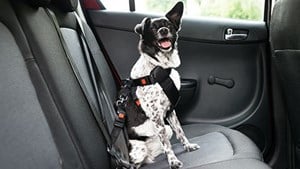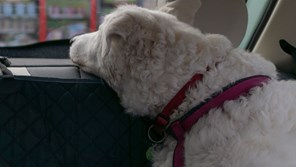Driving with a dog in the car
8 minute read

When taking a long journey, the easiest way to get from A to B with a dog is often by car. But there are some rules and regulations around driving with animals and securing them safely.
In this article, you can find out the laws around dogs in vehicles and how to strap them in safely.

Over 50s Car Insurance
Age Co helps drivers stay protected on the road. We’re 100% owned by Age UK and our profits go back to the charity.
Is it illegal to have a dog in the car?
No, it’s completely legal to have your dog in the car, so long as they’re properly strapped in and secured. This means you can take them with you on your travels, but they cannot be allowed to wander around the vehicle without a seatbelt or restraint of some kind.
How to travel with a dog in the car
Keep your pooch hydrated: before setting off, it’s a good idea to pack a bottle of water and a bowl so there’s a drink to hand, should you stop for a break. This may be particularly handy should you get stuck in traffic or worse still should you break down. You may also want to take some treats to keep them happy and reward them when they are well behaved.
Consider the temperatures: during colder weather spells, you might want to put a blanket in the car for them to sit on or cover them with. In particularly hot weather, you may wish to consider travelling early in the morning or later in the day to prevent overheating too. While window shades are designed for babies and young children, your dog may also benefit as they help keep cars cool and block out direct sunlight.
Never leave your dog in the car unattended: this goes for any time of the year, but it’s especially true in the summer months. It’s very dangerous and can have severe consequences, at the very least, they are likely to experience distress, discomfort and anxiety.
Factor in exercise breaks: just like we need to stretch our legs a bit on long drives, it's important to give your pet regular breaks too so they can go to the toilet, have something to drink, and get a little exercise.

Ways to keep your dog secure in the car
You should always keep your dog secure when driving, but how can you restrain them safely? The most popular methods are with a crate, a seat belt harness or a boot gate. Your dog may prefer one method over the others and so it can take some time to find the one that makes them feel safest and most comfortable.
Seat belt harness
Seat belt harnesses are one of the most popular restraints, because they allow your dog to sit on the backseat free from a cage, providing them some freedom but still restricting their movements.
As the seat belt harness fits on your dog, it may be a good idea to get them used to the harness on walks first. Once in your vehicle, the harness has an attachment that fits into the seat belt buckle, preventing them from moving too much.
It’s likely that this is the most popular method because dogs are generally happiest lying on the seat during the journey.
Crate
Crates are ideal for dogs who are already crate trained (for example if they sleep in one at night), because they will likely feel most comfortable in one.
It’s important that you get the sizing right – a crate that’s too big could allow too much movement for the dog should an incident occur, but they also need to be able to stand up, turn around, sit and lie down in it. For this reason, crates can take up a lot of space in the car and may not fit in a small vehicle.
If your dog isn’t already crate trained, being locked in one for a drive could be stressful for them, so it may be better to choose an alternative method to secure them.
Boot gate
Boot gates are popular for those who have multiple dogs or large breeds. They are fitted between the boot and the back seats so you can put them in the boot with no fear that they’ll jump onto the seats in front and distract the driver. They’re still able to move around freely and lie down.
It should be noted, however, that this method will protect you in an accident, but may not protect your dogs as much as a crate or seat belt harness.
Can a passenger hold a dog in the car?
Holding a dog is not an effective method of restraint. They can wriggle and get out of the passenger’s grasp or, because they’re not strapped in, could move around if there were to be an incident. For this reason, you shouldn’t simply hold a dog in the car, and should instead make sure they’re properly restrained with one of the methods above.
Can dogs travel in the front seat?
Dogs can travel in the front seat, as long as they’re restrained with a seat belt harness.
However, you should be sure to push their seat right back, so that they won’t be injured by the airbags should a collision occur. Alternatively, you can turn the passenger side airbags off temporarily.
Summary
Traveling with dogs can be challenging at times, but it’s also a great opportunity for you to bond with your four-legged friend on a dog-friendly trip. So, take the necessary precautions to ensure you and your dog travel safely and have a good time, such as:
- Make sure your dog can’t wander around the vehicle without a seatbelt or restraint of some kind.
- Popular ways to keep a dog secure in the car include a crate, a seat belt harness or a boot gate.
- Holding a dog on your lap, even a small breed, poses risks, as they can often wiggle free or be injured by airbags.
- Keep food and water in the vehicle, as well as a bowl for them to use. This will help them stay fed and hydrated on long journeys or in the event of a breakdown.
It is a risk to leave your dog unattended, especially in hot weather, as they can overheat. If you have to leave them in a parked vehicle, make sure you park in the shade.

Sign up to the Age Co Newsletter
Each month, our email newsletter delivers inspiring stories, practical guides to later life, plus the latest news about Age Co and the charitable work we support.
